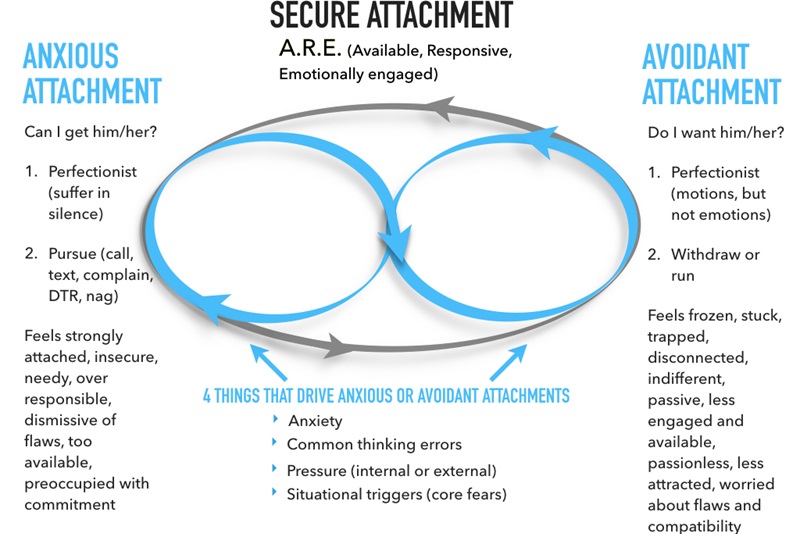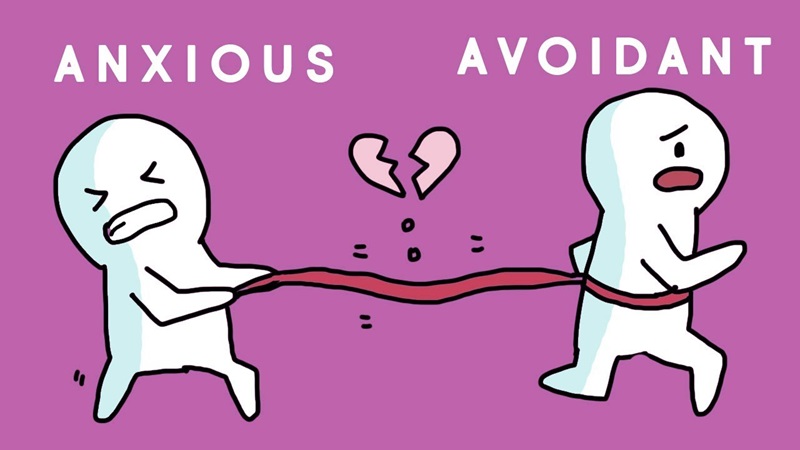Anxious and avoidant attachments often seem to gravitate towards one another due to a complex interplay of psychological needs and patterns. Individuals with an anxious attachment style are often preoccupied with their relationships, constantly seeking reassurance and intimacy.
They fear abandonment and are highly sensitive to any signs of rejection or withdrawal from their partners. On the other hand, those with an avoidant attachment style are characterized by a desire for independence, often perceiving closeness as a threat to their autonomy. They tend to suppress their feelings and maintain an emotional distance in relationships, which can lead to the dismissal of their partner’s needs.
This dynamic becomes a cycle, where the anxious person’s need for reassurance triggers the avoidant person’s need for distance, and vice versa. This push-pull relationship can create a sense of familiarity and predictability, which can be mistaken for compatibility. It’s a dance of opposites, where each person’s attachment style complements the other’s in a dysfunctional harmony.
However, it’s essential to understand that this pattern is often painful and unsatisfying, as it prevents both partners from having their emotional needs met in a healthy and fulfilling way. Breaking this cycle requires a conscious effort to understand one’s attachment style, communicate openly about emotional needs, and work towards developing a secure attachment style.

Understanding Anxious Attachment Styles
Understanding anxious attachment styles is a critical aspect of interpersonal relationships and self-awareness. This style, originating from early childhood experiences, is characterized by a deep-seated fear of rejection or abandonment. Individuals with anxious attachment styles often crave intimacy and closeness but constantly worry that others will not reciprocate their feelings.
They may also have a heightened sensitivity to perceived threats to their relationships, leading to behaviors that others might interpret as clingy or overly dependent. This attachment style is thought to be shaped by inconsistent or unpredictable responses from caregivers during infancy and early childhood. To manage their anxiety, these individuals may seek constant reassurance and validation from their partners, which can strain relationships.
It’s important to note that anxious attachment is not a personality flaw or defect, but rather a learned response to early environmental cues. Understanding and acknowledging this attachment style can pave the way for individuals and their partners to navigate the complexities of their relationships more effectively. Therapy, self-reflection, and open communication are all effective strategies for managing anxious attachment and fostering healthier relationships.
Exploring Avoidant Attachment Patterns
Avoidant attachment patterns can be traced back to early childhood experiences and are characterized by a consistent emotional distance from others. Individuals who exhibit this pattern tend to be self-reliant, independent, and often dismissive of others’ emotions or needs. This behavior is a self-protective mechanism designed to prevent potential rejection or pain. It’s a way of maintaining control and avoiding vulnerability.
The roots of avoidant attachment often lie in the nature of the caregiver-child relationship. If caregivers are emotionally unavailable, dismissive, or neglectful, the child learns to suppress their needs and emotions to avoid being a burden. As adults, they may struggle to establish deep, meaningful connections with others, avoiding emotional intimacy or even physical closeness.
In romantic relationships, individuals with avoidant attachment patterns might struggle with commitment, often preferring casual relationships. They may also be seen as emotionally unavailable, aloof, or dismissive. They could have a tendency to avoid conflict and may prefer to deal with problems on their own rather than seeking support or input from their partner.
In friendships and professional relationships, individuals with avoidant attachment patterns may seem independent and self-reliant. They may have a tendency to keep others at arm’s length, preferring to rely on themselves instead of seeking or accepting help from others. They may not share personal information or feelings readily, and they might be seen as detached or aloof.
However, it’s important to note that people with avoidant attachment patterns are not devoid of emotions or the desire for connection. In fact, they might deeply crave intimacy but have learned to suppress these needs to protect themselves from potential pain or rejection. Understanding and exploring these patterns can be a critical step towards healing and developing healthier, more secure relationships.

The Dynamics of Attachment Style Compatibility
The dynamics of attachment style compatibility play a critical role in shaping the nature of interpersonal relationships and the subsequent emotional and psychological outcomes for the individuals involved. Attachment styles, originally defined by John Bowlby, are essentially the patterns of attachment behavior exhibited by individuals, specifically in the context of intimate relationships.
These styles, broadly categorized into secure, anxious, and avoidant, significantly influence the dynamics of a relationship. The compatibility between the attachment styles of partners can either foster a healthy and fulfilling relationship or lead to emotional distress and dysfunctionality. For instance, two securely attached individuals are likely to have a stable and satisfying relationship as they are capable of providing and receiving emotional support.
Meanwhile, a relationship between an anxiously attached individual and an avoidantly attached individual will likely result in a tumultuous and unstable relationship, given their contrasting needs and responses. The anxious individual craves closeness and reassurance, which the avoidant individual, who values independence and has a fear of closeness, struggles to provide. This can lead to a vicious cycle of one partner perpetually seeking reassurance and the other continually pulling away.
Therefore, exploring and understanding the dynamics of attachment style compatibility can provide valuable insights into the functioning of relationships and serve as a tool for improving relational satisfaction and stability. It can also aid in resolving relational conflicts and improving communication by enabling individuals to understand and respect their partner’s attachment style and associated needs. Thus, attachment style compatibility is a fundamental aspect that shapes the nature and quality of interpersonal relationships.
Why Opposites Attract: Psychological Perspectives
Opposites attract from a psychological perspective due to a variety of intriguing reasons. One of the primary theories is the complementary hypothesis, which suggests that individuals are attracted to those who possess traits or abilities they lack. This phenomenon can be seen as a subconscious desire to balance one’s own deficiencies or enhance personal growth.
For instance, an introverted individual might be drawn towards an extroverted partner, appreciating their ease in social situations and their ability to bring vibrancy into their lives. Another theory is the compensation hypothesis, which proposes that people are attracted to the opposite characteristics that compensate for their own shortcomings. For example, a person who may consider themselves as less disciplined might be attracted to someone who is highly organized and disciplined.
This is because the latter’s traits are perceived as beneficial and desirable, offering a sense of balance. Moreover, the allure of novelty and excitement that comes with differences can also be a driving force in attraction. Engaging with someone who differs from us dramatically can stimulate curiosity, foster learning, and promote personal growth.
However, it’s crucial to note that while the initial attraction might be fueled by these differences, long-term relationship success often requires shared values and common goals. Nonetheless, the psychological concept of why opposites attract remains a fascinating area of exploration, shedding light on the intricate dynamics of human attraction and relationships.

Managing Relationship Challenges with Different Attachment Styles
Managing relationship challenges with different attachment styles often necessitates a nuanced understanding of individual emotional needs and ways of communicating. This can be a complex process, as each person has their unique attachment style, often rooted in early childhood experiences. These styles, broadly categorized as secure, anxious, avoidant, and disorganized, significantly influence how we interact with and perceive our partners.
For example, those with a secure attachment style tend to feel comfortable with intimacy and are usually warm and loving. They can often navigate relationship challenges with relative ease. On the other hand, an anxious attachment style might result in individuals feeling insecure and needing constant reassurance about their partner’s feelings. This could lead to misunderstandings, conflicts, and undue stress in the relationship.
Meanwhile, those with an avoidant attachment style might struggle with expressing their feelings and may prefer maintaining a certain level of emotional distance. They might also find it difficult to depend on others, causing their partners to feel neglected or unimportant. Lastly, individuals with a disorganized attachment style often experience contradictory emotions of wanting closeness but fearing it at the same time. They may have erratic behaviors that confuse their partners.
Successfully managing relationship challenges with different attachment styles requires patience, understanding, and communication. Partners must strive to understand each other’s attachment style and how it affects their behavior and reactions. This can help foster a more empathetic and supportive relationship environment. Acknowledging and respecting these differences is essential for building a long-lasting, fulfilling relationship. Moreover, seeking professional help, like couples therapy, can provide useful tools and strategies to better navigate these challenges.
In conclusion, understanding and managing different attachment styles is crucial in maintaining healthy relationships. It allows partners to communicate more effectively, handle conflicts more constructively, and ultimately strengthen their bond.
